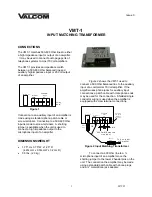
7
Tel: 1/888/525-7300 • Fax: 1/435/753-7490 • www.apgsensors.com • [email protected]
Your PT-400 series pressure transmitter is very low maintenance and will need little care as long as it is
installed correctly. However, in general, you should:
•
Keep the transmitter and the area around it generally clean.
•
Avoid applications for which the transmitter was not designed, such as extreme temperatures, contact
with incompatible corrosive chemicals, or other damaging environments.
•
Inspect the threads whenever you remove the transmitter from duty or change its location.
•
Avoid touching the diaphragm. Contact with the diaphragm, especially with a tool, could permanently
shift the output and ruin accuracy.
•
Clean the diaphragm or the diaphragm bore with extreme care. If using a tool is required, make sure it
does not touch the diaphragm.
Chapter 3: Maintenance
• General Care
•
Zero Trimming
•
Remove protective screw(s) with 5/64 allen wrench.
•
Ensure that the transmitter is at 0 psig or 0 psia (vacuum if absolute).
•
Using a jeweler’s screwdriver or a suitable instrument, adjust the “Z” pot until you have a 4 mA, 0 V,
0.5 V, or 1 V output.
•
Replace protective screws(s) when finished.
IMPORTANT
: Do not make changes to the Span adjustment (the “S” pot to the right,
see Figure 3.1) as part of the zero trimming. The Span should only be changed as part of
the recalibration of a gauge with a known pressure source.
Figure 3.1
Zero & Span
Adjustment
DANGER
: Protective screws must be replaced using 28 oz-in of torque to create seal.








































